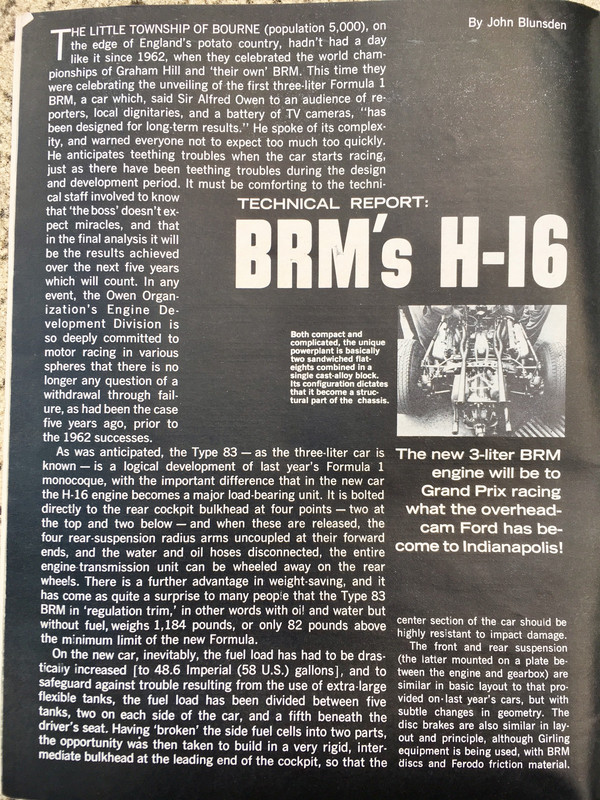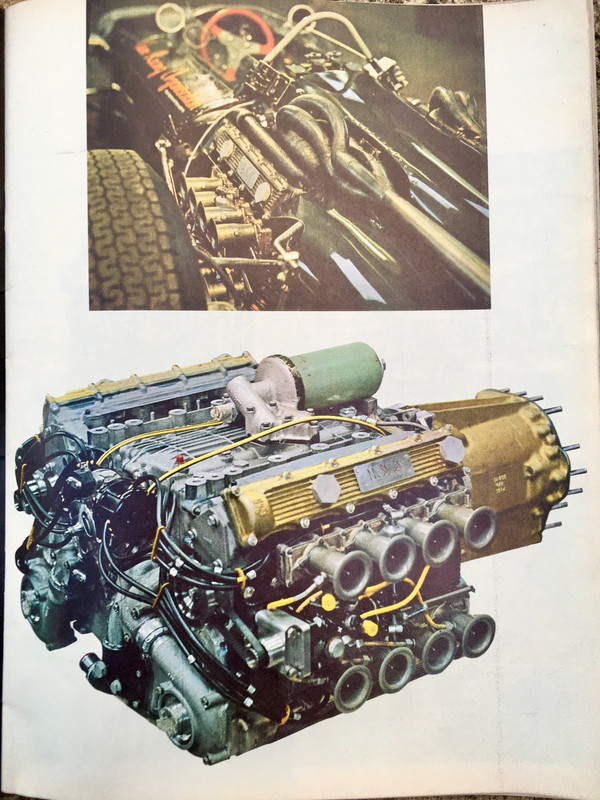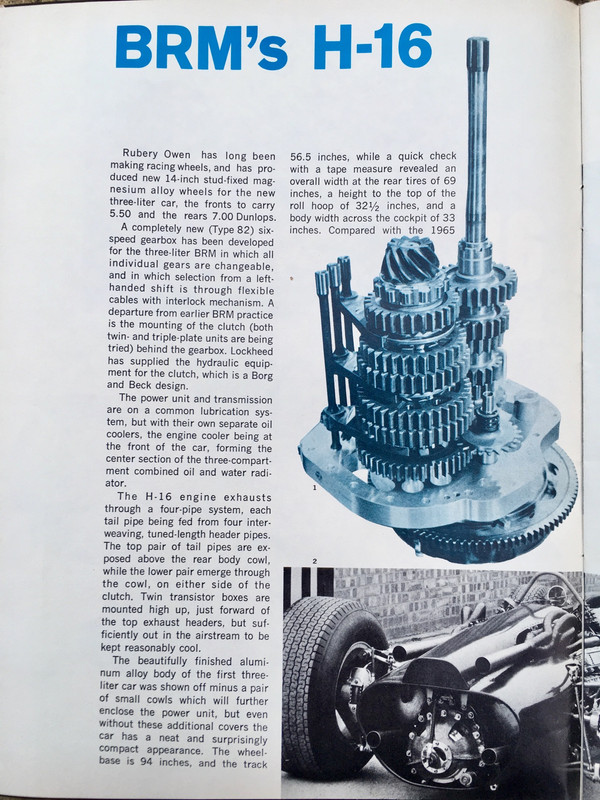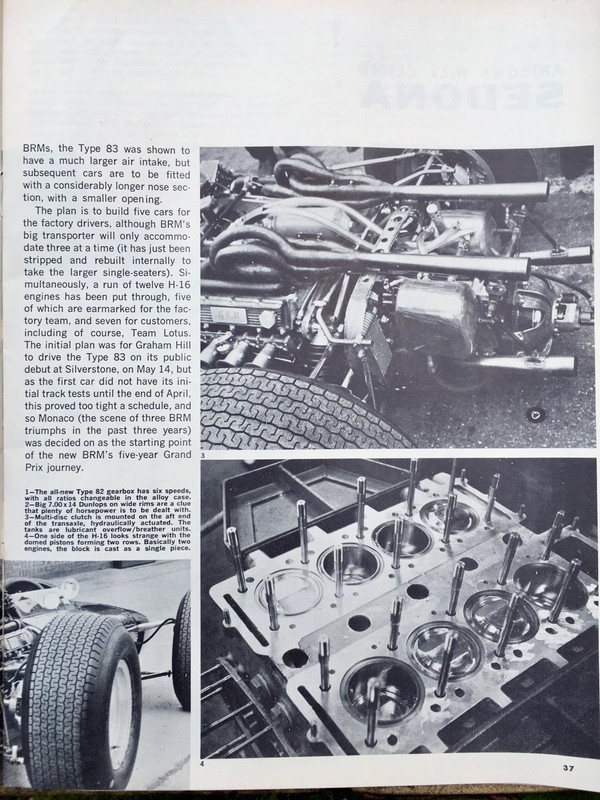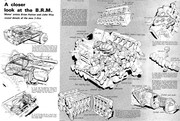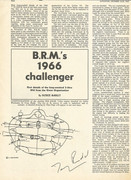BRM H16
#1

Posted 23 October 2001 - 01:16
Advertisement
#2

Posted 23 October 2001 - 04:11
The H16 in 1967 weighed 484lb.
Against 356lb for the all conquering DFV.
The P83 BRM weighed 1,450lb. The (Lightweight
Against the 1,105lb of the Lotus 49.
#3

Posted 23 October 2001 - 04:12
I would like to provide more but the old folks home I am in has a limited library!
#4

Posted 23 October 2001 - 11:10
"We knew we had a weight problem with the H16 when it arrived from BRM and it took four men to lift it off the lorry"
Can I have my Viagra now please nurse?
#5

Posted 23 October 2001 - 13:58
Originally posted by Mike Argetsinger
Originally (1966) 555 lbs. (252 kg) plus 118 lb. (53.5 kg) of gearbox and clutch according to Tony Rudd (who ought to know!) - In his book "It Was Fun -My Fifty Years of High Performance". By 1967 he quotes 508 lbs. (231 kg).
And what a whopping contrast to the plan! Setright (The Grand Prix) quotes a preliminary study from within BRM which suggested they could come in at 380lb.
Pordon the font size. The old eyes are playing up tonight.
Vanwall.
#6

Posted 23 October 2001 - 23:15
Of course, life was harder in those days, we had to get up three hours before we went to bed...
#7

Posted 24 October 2001 - 22:24
M.L. Anderson
#8

Posted 25 October 2001 - 12:07
The H16 engine will never be remembered as a great success, but in less than two years of racing it managed one GP win, one second, and numerous points placings. That's about the same success rate as the Weslake and Honda V12s. Both of these were relatively simple designs but they don't get slagged off like the H16.
#9

Posted 25 October 2001 - 16:16
Originally posted by marion5drsn
BRM H-16, The people who designed this engine must have been related to the people the made the Napier Sabre ...The Sabre was so touchy that the engine had to have heated air warning before it could even be started before a mission!
Funny you should say that! Setright cites Tony Rudd's paper to the Institution of Mechanical Engineers in 1968 (chronicling the failure of the H-16) in which he states: "Experience was available on H engines including the Napier range."
Setright goes on to say: "Available it may have been, but it does not seem to have been drawn upon in matters of detail. The Sabre, for instance, had an exquisite system of floating gears to balance the loading imparted to the drive train from each of the two crankshafts; but the BRM just had undersized torsion shafts and a crude spur gear connection between the two shafts, and this was developed on the wicked old basis of 'make it stronger if it breaks'. When it stops breaking, something else usually starts; and in fact most of the really serious trouble was the result of torsional vibration problems originating in the shafts. As a temporary measure, heavy steel rings were bolted onto four of the webs of each crankshaft to increase the inertia, and the engine was raced like this through 1966 ..."
Doesn't it make you cringe?
Finally back to the Sabre (as fitted in the Hawker Typhoon 1B) ... I am amused by the words one of the pilots from 198 (Fighter) Sqn caused to have painted on the radiator fairing: "IF THIS ENGINE CATCHES FIRE ON STARTING, DON'T JUST WAVE YOUR ARMS AT THE PILOT, TRY PUTTING THE BLOODY THING OUT AS WELL."
Vanwall
#10

Posted 26 October 2001 - 00:39
Actually, I heard the H-16 run at The Glen in 1966, and it sounded pretty neat (when it was running right!!)
Bobbo
#11

Posted 26 October 2001 - 20:27
There must be at least one made into a coffee table?
museum@f1power.com
#12

Posted 26 October 2001 - 23:49
Bobbo
#13

Posted 27 October 2001 - 12:52
Peter
#14

Posted 08 November 2001 - 21:56
"Although a 12-cylinder engine was considered, Rudd’s choice fell on a radical 16-cylinder engine composed of two horizontally-opposed eights placed one atop the other and geared together. Estimates were that it would weigh 380 pounds and produce 500 bhp – figures which, in the event, were destined to be interchanged."
#15

Posted 08 November 2001 - 22:10
Originally posted by karlcars
My new book, Classic Racing Engines, has a chapter on the H-16. It includes these sentences:
"Although a 12-cylinder engine was considered, Rudd’s choice fell on a radical 16-cylinder engine composed of two horizontally-opposed eights placed one atop the other and geared together. Estimates were that it would weigh 380 pounds and produce 500 bhp – figures which, in the event, were destined to be interchanged."
Karl,
First Roger and now YOU! -- Did I detect a whiff of cynicism in that last line: "...figures which, in the event, were destined to be interchanged.."
#16

Posted 09 November 2001 - 17:13
Originally posted by 930fly
We now no that a high-revving lightweight V8 was the way to go, but that is with hindsight.
Well, i think in the end the 180-degree V12 turned out to be the best idea.
The H16 engine will never be remembered as a great success, but in less than two years of racing it managed one GP win, one second, and numerous points placings. That's about the same success rate as the Weslake and Honda V12s. Both of these were relatively simple designs but they don't get slagged off like the H16.
Right. All engines designed is the beginning turned out to be not so good ideas. Only the Repco's did well. And as a result the DFV was designed.
Of all the starting teams, only Ferrari (with the very succesfull flat12) and BRM (with a conventional V12) took a second chance. And also the BRM V12 was not without success. in the end of 1971 the BRMs were the cars to beat.
mat1
#17

Posted 11 November 2001 - 22:22
Originally posted by marion5drsn
The Sabre was so touchy that the engine had to have heated air warning before it could even be started before a mission!
Just like any Formula 1 engine in 2001!
Is this progress?
#18

Posted 12 November 2001 - 11:13
Peter
#19

Posted 13 July 2015 - 10:35
Can anyone point me to a picture of a BRM or Lotus with the cross-over exhaust?
Advertisement
#20

Posted 14 July 2015 - 21:01
No.
All the photos and drawings in the many reprinted articles in the Unique Motor Books volume on BRM Cars show 4 independent bunches of exhausts, with various components on top of the engine (including a large oil filter), under a spine in the engine cover when fitted, which would have prevented such a system. Tony Rudd's own paper presented to the IMechE makes no mention of cross-coupled exhausts, even for dyno tests.
I have seen it mentioned somewhere that Richie Ginther suggested reversing the cylinder heads of the V8 so that the exhausts would be close enough to be cross-linked like the early Climax FWMV, but again have never seen such an arrangement on the centre-exhaust V8s.
Oddly, a displayed Climax FWMV that was in the Donington Collection last time I visited had a high-level exhaust system fitted, but with no cross-connection of the collectors; I thought that flat-crank FWMVs always had low-level tailpipes, so perhaps it was a modern inaccurate replica system.
Paul M
#21

Posted 15 July 2015 - 05:54
That's exactly what I thought about the H16, yet Doug said that Len Terry told him the story about cross-linked exhausts.
There is some discussion about the Climax FWMV exhaust in this thread: http://forums.autosp...cts/?hl=+climax
I think the conclusion was that from some point in 1963, all Climax V8s were flat-crank and had no need of linked exhausts. Some manufacturers preferred to retain high-level exhausts even though the were no longer linked. The same is true of cars in historic racing today.
#26

Posted 28 July 2018 - 17:05
BRM may have underestimated the weight of the H16 when talking to journalists, and to customers. In Team Lotus, Andrew Ferguson quotes 565 lbs for the Indy version, against a promised 425 lb, which ties in with Tony Rudd's number. The Indy engine - which only ran in the back of a Lotus 42 once - shared major vibration problems with its F1 sister, and the solution in F1 was to strengthen it, which can only have added weight. The Indy engine was simply abandoned.
I wrote a bit about the Lotus 42 here:
http://www.oldracingcars.com/lotus/42/
#28

Posted 30 July 2018 - 11:52
In the 1930s, Italians experimented with two engines in a GP class or Formule Libre car. I don't recall any significant win.
The BRM H16 is brilliantly packaged but it comprises two engines on a common crankcase (or output shaft). There are two of every ancillary component. There's too much stuff to go wrong.
#29

Posted 30 July 2018 - 14:19
In the 1930s, Italians experimented with two engines in a GP class or Formule Libre car. I don't recall any significant win.
There are several cars to which you may be referring.
The V4 Maserati had two straight 8 2-litre engines from the 26B, mounted side-by side on a common crankcase. It won the Tripoli Grand Prix in 1930. The V5 was a larger engined version. The Tipo A Alfa Romeo had two six-cylinder 1750cc engines, similarly mounted side-by-side. It won the 1931 Coppa Acerbo. The Maserati and the Alfa appeared at a time when Grand Prix racing was run to Formule Libre. Their weight and power frightened the authorities and encouraged the introduction of a new formula in 1934, limiting maximum weight, and intended to encourage smaller and lighter cars. It was not entirely successful in this.
In 1935, Scuderia Ferrari built the Bimotore Alfa Romeo which had engines in front of and behind the driver. It was very fast but could not get close to the weight limit so was confined to Formule Libre events.
#30

Posted 30 July 2018 - 15:00
Thanks, Roger.
#31

Posted 30 July 2018 - 18:41
Don't forget the AAC 815 built by Enzo Ferrari. Its straight eight engine was essentially two Fiat 508 4-cylinder engines on a common crankshaft and crank case.
#32

Posted 30 July 2018 - 20:38
In the 1930s, Italians experimented with two engines in a GP class or Formule Libre car. I don't recall any significant win.
The BRM H16 is brilliantly packaged but it comprises two engines on a common crankcase (or output shaft). There are two of every ancillary component. There's too much stuff to go wrong.
I give you "Chatter." Same problem Ron Marchant had with his V12 Arial Arrow engined Lotus 23.
#34

Posted 31 July 2018 - 08:28
#35

Posted 31 July 2018 - 09:36
Sorting the crank vibrations out on Ron Marchant's Ariel device must have been optimism over expectations, as the engine was in fact two banks, each of 3 vertical twins, the banks being laid out in a V formation, but I always applaud people who try something different with the potential for achievement. Bolster was very enthusiastic when he wrote about its test at Silverstone in period, ISTR, and the noise it made at the FoS a while back was excellent, albeit seemingly on a limited throttle opening.
I think overheating was always likely to be a problem, but I have/have seen programme entries for it in several events in period.
Roger Lund
#36

Posted 31 July 2018 - 10:04
OT a bit, and it is a while since I have thought about this sort of stuff, but ISTR Bugatti making a U16 motor, and there was a Stutz device using , was it 2 Millers?, on a common crank, in the 1920s, and ages ago I came across a U8 built by Matra Simca based on 2 Ranchero engines, and Bolster put 2 engines in line in one of his devices.
Sorting the crank vibrations out on Ron Marchant's Ariel device must have been optimism over expectations, as the engine was in fact two banks, each of 3 vertical twins, the banks being laid out in a V formation, but I always applaud people who try something different with the potential for achievement. Bolster was very enthusiastic when he wrote about its test at Silverstone in period, ISTR, and the noise it made at the FoS a while back was excellent, albeit seemingly on a limited throttle opening.
I think overheating was always likely to be a problem, but I have/have seen programme entries for it in several events in period.
Roger Lund
I recall looking down upon it in his garage in Cuffley and shaking my head in disbelief...
#37

Posted 31 July 2018 - 10:11
#38

Posted 01 August 2018 - 08:48
If the old Racing Legends sim is anything to go by - and it seemed quite realistic in many other ways - the BRM H16 had a particularly narrow power-band, which is presumably why it came with a six-speed gearbox when five speeds seemed enough for everyone else. Keeping the Beast on the boil while pandering to the car's other foibles must have been, shall we say, interesting.
#39

Posted 01 August 2018 - 12:00
I don't know why, however, it would have a narrow torque band.
Advertisement
#40

Posted 01 August 2018 - 12:14
I don't know why, however, it would have a narrow torque band.
Nobody complained that the 1.5 litre V8 had a narrow torque band, so it is unlikely that anything significant changed for the H16. Apart from mass. In 1967, the H16 was about 35% heavier than a DFV. The same problem applied to McLaren's modified Ford Indy engine or Cooper's ageing Maserati.
#41

Posted 01 August 2018 - 12:47
Apart from mass. In 1967, the H16 was about 35% heavier than a DFV. The same problem applied to McLaren's modified Ford Indy engine or Cooper's ageing Maserati.
At Indy, the difference in weight between a Ford quad-cam and a BRM H16 was almost exactly the same weight as Jim Clark!
#42

Posted 01 August 2018 - 20:26
The U16 Bugatti was an aero-engine produced during the 1914-18 war but without any success. The story of the engine and it’s influ on subsequent American designs is told in detail in Bugatti By Borgeson.
That's an old Bugatti myth. The only influence the engine can have had on American designers is how not to do it! As Roger already remarked, the U16 was a total failure, and none of its design features were found in subsequent US racing engines of note.
#43

Posted 01 August 2018 - 22:27
I don't know why, however, it would have a narrow torque band.
A piece out of an issue of Motor Racing in which John Blundsen Blunsden goes into the power and torque characteristics of the H-16
macoran
Edit John Blunsden's name spelling
Edited by StanBarrett2, 01 August 2018 - 22:31.
#44

Posted 02 August 2018 - 06:27
In fairness to Griffith Borgeson, he does make that clear. A lot of his book is concerned with debunking Bugatti myths.That's an old Bugatti myth. The only influence the engine can have had on American designers is how not to do it! As Roger already remarked, the U16 was a total failure, and none of its design features were found in subsequent US racing engines of note.
#45

Posted 02 August 2018 - 06:51
#46

Posted 02 August 2018 - 12:45
The Tasman cars also had 6-speed boxes, of course.
#47

Posted 02 August 2018 - 17:22
It’s interesting that John Blunsden, in the Motor racing article, mentions the influence of the H24 Eagle engine. I don’t think Tony Rudd mentions the Eagle in his autobiography in either the Rolls-Royce or the H16 chapters. He does say that the only successful H configuration engine had been the Napier Sabre.
Well I suppose Rolls "copied" a lot of the Napier Sabre's features for the Eagle particularly the "Flat" H arrangement and sleeve valves after their experience with the unsuccessful "X" configuration Vulture. So with Rudd working for Rolls and only about 15 Eagles being produced and only being used in prototype Westland Wyverns (where the only one left today is at the FAA Museum at Yeovilton IIRC) I suppose it would only be natural to refer to the more widely used and "successful" Napier Sabre when talking about "Flat" H Engines.
What they should have known and is possibly hinted at by his Lordship's comments about not expecting immediate results was that the Napier Sabre really only reached acceptable levels of reliability and much higher power after a LOT of development through about 8 Number Variants and 2 Experimental Versions. You only have to compare an early model Typhoon with the Sabre I of about 2000hp to the Fury LA610 with the Sabre VII of just over 3000hp. At that rate a BRM H16 may have been competitive in about 1974 - imagine that in the back of the P201!
I wrote "Flat" H up there as well because it always intrigues me that slapping two "Flats" on top of each other doesn't really look like a "H" but more like a "Capital i". To me the "real" "H" configuration engines are the Napier Rapier and Napier Dagger.
Edited by oldjonesfan, 02 August 2018 - 17:30.
#48

Posted 02 August 2018 - 18:09
What impact would doubling the number of firing strokes have on the torque curve? I’m not doubting you - I just don’t know. In fact the early H16s fired two cylinders at once; it was only at the end of 1966 that they began to fire like a genuine 16.It's also interesting that they assume the 1.5's torque curve will carry over to the 3.0-litre despite there being twice as many firing strokes...
The Tasman cars also had 6-speed boxes, of course.
I think most V8 BRMs had six speeds from the introduction of the P62 ‘box in 1963. The old five-speed P27 had been inherited from the 2.5-litre cars and was far too heavy. They also experimented with a six-speed Colotti on Ginther’s car in 1962 but without success.
#49

Posted 23 May 2021 - 16:48
Since they lightened the chassis by 55kgs with the magnesium cockpit, but the engine by only 20kgs, wouldn't have that sent the weight bias even further rearward and made the P115 a worse handling car?
Just making LOTS of assumptions of course...
#50

Posted 23 May 2021 - 18:11
Assuming the Lotus 49 had a 55-56% rearward weight bias, my estimations are that the original P83 would have had around 57-58%.
Since they lightened the chassis by 55kgs with the magnesium cockpit, but the engine by only 20kgs, wouldn't have that sent the weight bias even further rearward and made the P115 a worse handling car?
Just making LOTS of assumptions of course...
Jackie Stewart supposedly liked twitchy cars but probably not the BRM. 1966 and 1967 must have been desperate years for him.









